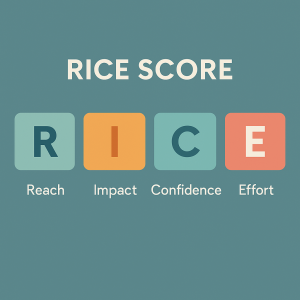As a project manager, I constantly face the challenge of deciding which initiatives deserve priority. With limited time and resources, making the right choices is crucial. That’s where RICE Scoring comes into play. It’s my go-to framework for making objective, data-driven prioritization decisions.
RICE stands for Reach, Impact, Confidence, and Effort.
- Reach helps me quantify how many users or customers will be affected by a project.
- Impact determines how significantly it will influence them.
- Confidence ensures I have enough data to back up my assumptions, preventing guesswork from skewing decisions.
- Effort calculates the time and resources required, helping me assess feasibility.

By using a simple formula—multiplying Reach, Impact, and Confidence, then dividing by Effort—I get a clear prioritization score.
This method has transformed the way I plan and execute projects. Instead of relying on intuition or loudest-voice decision-making, I have a structured approach that aligns with business goals. RICE allows me to justify my choices to stakeholders and stay focused on what truly matters. If you’re struggling with prioritization, give RICE Scoring a try. It might just revolutionize your workflow as it did mine.
After implementing RICE scoring into my prioritization process, I quickly realized its true power lies not just in setting initial priorities but in continuously guiding decision-making throughout a project’s lifecycle. Using RICE helps me ensure that I am focusing on the most impactful initiatives while remaining flexible enough to adapt as new information emerges.
When starting a project, I apply RICE scoring to assess which initiatives will deliver the most value with the least effort. However, as projects progress, new challenges, data, and market shifts can alter priorities. That’s why I revisit and adjust RICE scores periodically. A task that initially seemed high-impact may turn out to have unforeseen dependencies, increasing its Effort score and lowering its priority. Conversely, a lower-priority task may become more valuable due to changing business goals, increasing its Impact or Reach score.
The flexibility of RICE allows me to keep my workflow dynamic. By regularly re-evaluating each initiative’s score, I can ensure that my team remains focused on what truly matters. It also provides a structured way to justify changes to stakeholders, helping to maintain alignment and avoid wasted resources.
Integrating RICE into an adaptive planning cycle has transformed the way I manage projects. If you want to stay ahead of shifting priorities and maximize efficiency, try continuously leveraging RICE scoring throughout your project’s lifecycle. It’s more than just a prioritization tool—it’s a strategic asset that evolves with your needs.
